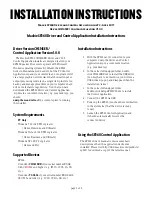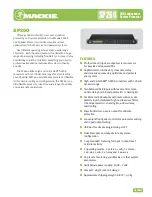
1
11
KONA LHi Installation and Operation Manual — In This Manual
Component video signals are generally higher quality than composite, but not as high quality as
serial digital (SDI).
A Note About RGB
—Although RGB is used less in today’s video systems, KONA LHi supports
it. However, because the KONA LHi (and SMPTE SDI) native format is YPbPr, AJA
recommends the use of YPbPr whenever possible for analog monitoring. Although
component video monitors often have RGB inputs, it’s better to use YPbPr when the
monitor supports it. The YPbPr format provides “headroom” for “superwhite” and
“superblack”—and these video levels
will be clipped
when transcoding to RGB. Also, the
RGB/YPbPr transcoding involves a level translation that results in mathematical round-off
error. RGB can be configured in the KONA LHi Control Panel.
A Note About YPbPr
—Component Video, or YPbPr, has been given several names over time.
YUV, Y/R-Y/B-Y, and YCbCr, are just some examples. Although these various formats have
some differences in levels, they are all basically the same. KONA LHi uses the modern YPbPr
terminology exclusively. KONA LHi supports three different types of YPbPr: SMPTE/EBU
N10, Betacam (NTSC), and Betacam (NTSC Japan). These three formats differ in level only
and are configured in the KONA LHi Control Panel.
Reference Video and LTC Input
A single BNC on the standard KONA LHi cable—or two BNC connectors on KLHi-Box (it loops
through)—allow you to synchronize KONA LHi outputs to your house analog reference video
signal (or black burst). If you have a sync generator or central piece of video equipment to use
for synchronizing other video equipment in your studio, then connect its analog composite
output here. When KONA LHi outputs video it uses this reference signal to lock to. When
connecting a reference video source, the locking signal should be the same format as the
Primary format selected in the KONA Control Panel. It is possible in some circumstances to use
an alternate format video signal as long as the basic frame rate is compatible.
The Reference Video input can also be used for LTC input. The hardware automatically detects
sync or LTC and acts appropriately.
In This Manual
Chapter 1 is the introduction you’re reading, listing features, box contents, and system
requirements.
Chapter 2 gets you started with using KONA LHi in a typical Video environment. Typical
workflows are discussed.
Chapter 3 provides complete instructions for installing and configuring the AJA KONA LHi card.
The user is guided through unpacking, installing the card into a PowerMac, installing KONA LHi
Mac Software From CD, cabling the system and then getting it up and running. Important
configuration information is also provided on video settings and use of genlock/external
reference.
Chapter 4 discusses operational aspects of KONA LHi when used with Final Cut Pro.
Chapter 5 discusses troubleshooting problems with your system and what to do when there’s a
problem you can’t solve.
Appendix A presents a list of technical specifications for the product.
Appendix B gives a glossary of technical terms and acronyms used in the manual.
The remainder of the manual consists of appendices listing specifications and an index section
to help you rapidly find topics in the manual.
Summary of Contents for KONA LHI
Page 4: ...iv ...
Page 18: ...12 ...
Page 24: ...18 ...
Page 74: ...68 ...
Page 78: ...70 ...
Page 82: ...A 4 ...
Page 86: ...I 4 Yellow 34 YPbPr 11 YUV 11 Z Zoom 14 9 38 Zoom Letterbox 38 Zoom Wide 38 ...















































